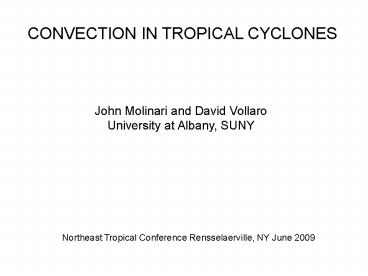CONVECTION IN TROPICAL CYCLONES - PowerPoint PPT Presentation
Title:
CONVECTION IN TROPICAL CYCLONES
Description:
Application to Tropical Storm Gabrielle (2001) ... TROPICAL STORM GABRIELLE (2001) ... TS Gabrielle summary. Upper trough approached a weak tropical storm ... – PowerPoint PPT presentation
Number of Views:45
Avg rating:3.0/5.0
Title: CONVECTION IN TROPICAL CYCLONES
1
CONVECTION IN TROPICAL CYCLONES
John Molinari and David Vollaro University at
Albany, SUNY
Northeast Tropical Conference Rensselaerville, NY
June 2009
2
- Distribution of the potential for severe cells
in tropical cyclones using CAMEX dropsondes - Application to Tropical Storm Gabrielle (2001)
3
Molinari and Vollaro (2008) used CAMEX sondes to
evaluate the environment of intense local cells
in Hurricane Bonnie (1998) using midlatitude
convective parameters EHI energy-helicity
index Empirical index for predicting supercells
(and tornadoes) in midlatitudes EHI is the
product of normalized cell-relative helicity (0-3
km) and normalized CAPE
4
Hurricane Bonnie study has been repeated for all
CAMEX storms Next distribution of EHI with
respect to the center of all tropical cyclones
sampled by dropsondes in the CAMEX experiments,
rotated with respect to ambient vertical wind
shear, for large and small ambient shear.
5
AMBIENT
r 400 km
SHEAR
SMALL SHEAR lt10 M/S
LARGE SHEAR 10 M/S
Distribution of EHI values with respect to
ambient wind shear in CAMEX-observed tropical
cyclones. Left panel small ambient shear. Right
panel large ambient shear. Gray circles severe
cells unlikely. Red circles likelihood grows
with circle diameter.
6
TROPICAL STORM GABRIELLE (2001)
Infrared satellite image at 0715 UTC 14
September. Also shown are Air Force
reconnaissance 850 hPa winds (0600-0730 UTC) and
cloud-to-ground lightning flashes from 0530-0730
UTC. Surface winds are at 0700 UTC.
7
Potential vorticity and winds on the ? 350K
surface at 0000 UTC 14 September 2001.
8
Potential vorticity and winds on the ? 350K
surface at 1200 UTC 14 September 2001.
9
Infrared satellite image (colors) at 1800 UTC 13
September 2001. Red shading indicates Tb lt -72ºC.
Yellow numbers indicate 0-3 km helicity values
(m2 s-2) calculated from ECMWF analyses at the
same time. The hurricane symbol shows the best
track center.
10
Same as previous, but for 6 hours later, at 0000
UTC 14 September.
11
Same as previous, but for an additional 6 hours
later, at 0600 UTC 14 September. The asterisk
indicates the location of center reformation less
than three hours later. Reconnaissance aircraft
found a 972 hPa pressure at that point, 20 hPa
lower than 3 hours before.
12
Next radar reflectivity from Tampa, 70 km
northeast of the newly developing center Focused
on area of asterisk in previous image Circles
will indicate mesocyclones detected by the
automated radar algorithm Entire image is about
60 km across 5 minutes of lightning is shown by
signs (positive cloud-to-ground flash) and
signs (negative C-G flash)
13
mesocyclone ? 2.9 X 10-2 s-1 z 2-7 km D 10km
14
? 2.8 X 10-2 s-1 D 14 km
15
20 dBZ contour
Schematic supercell from Lemon and Doswell (1979)
16
- TS Gabrielle summary
- Upper trough approached a weak tropical storm
- Ambient shear increased, and in-up-out flow
strengthened downshear - As a direct result, helicity rose downshear
- Long-lived cells developed in the same region
- One of these cells appeared to become the
location of a center reformation































